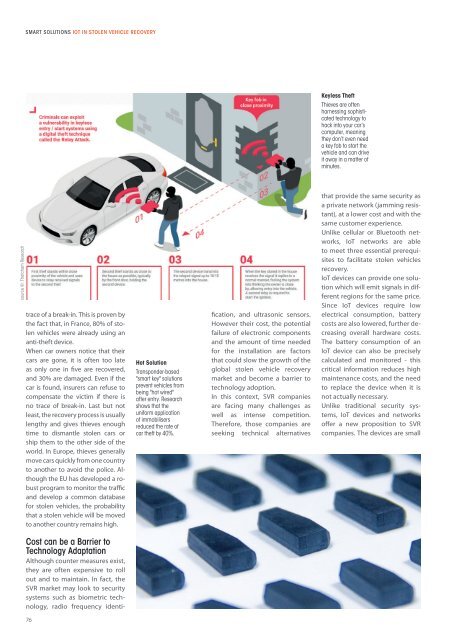Smart Industry 2021
Smart Industry 2021 - The IoT Business Magazine - powered by Avnet Silica
Smart Industry 2021 - The IoT Business Magazine - powered by Avnet Silica
- No tags were found...
Create successful ePaper yourself
Turn your PDF publications into a flip-book with our unique Google optimized e-Paper software.
<strong>Smart</strong> Solutions IoT in stolen vehicle recovery<br />
Keyless Theft<br />
Thieves are often<br />
harnessing sophisticated<br />
technology to<br />
hack into your car’s<br />
computer, meaning<br />
they don’t even need<br />
a key fob to start the<br />
vehicle and can drive<br />
it away in a matter of<br />
minutes.<br />
source ©: Thatcham Research<br />
trace of a break-in. This is proven by<br />
the fact that, in France, 80% of stolen<br />
vehicles were already using an<br />
anti-theft device.<br />
When car owners notice that their<br />
cars are gone, it is often too late<br />
as only one in five are recovered,<br />
and 30% are damaged. Even if the<br />
car is found, insurers can refuse to<br />
compensate the victim if there is<br />
no trace of break-in. Last but not<br />
least, the recovery process is usually<br />
lengthy and gives thieves enough<br />
time to dismantle stolen cars or<br />
ship them to the other side of the<br />
world. In Europe, thieves generally<br />
move cars quickly from one country<br />
to another to avoid the police. Although<br />
the EU has developed a robust<br />
program to monitor the traffic<br />
and develop a common database<br />
for stolen vehicles, the probability<br />
that a stolen vehicle will be moved<br />
to another country remains high.<br />
Hot Solution<br />
Transponder-based<br />
"smart key" solutions<br />
prevent vehicles from<br />
being "hot wired"<br />
after entry. Research<br />
shows that the<br />
uniform application<br />
of immobilisers<br />
reduced the rate of<br />
car theft by 40%.<br />
fication, and ultrasonic sensors.<br />
However their cost, the potential<br />
failure of electronic components<br />
and the amount of time needed<br />
for the installation are factors<br />
that could slow the growth of the<br />
global stolen vehicle recovery<br />
market and become a barrier to<br />
technology adoption.<br />
In this context, SVR companies<br />
are facing many challenges as<br />
well as intense competition.<br />
Therefore, those companies are<br />
seeking technical alternatives<br />
that provide the same security as<br />
a private network (jamming resistant),<br />
at a lower cost and with the<br />
same customer experience.<br />
Unlike cellular or Bluetooth networks,<br />
IoT networks are able<br />
to meet three essential prerequisites<br />
to facilitate stolen vehicles<br />
recovery.<br />
IoT devices can provide one solution<br />
which will emit signals in different<br />
regions for the same price.<br />
Since IoT devices require low<br />
electrical consumption, battery<br />
costs are also lowered, further decreasing<br />
overall hardware costs.<br />
The battery consumption of an<br />
IoT device can also be precisely<br />
calculated and monitored - this<br />
critical information reduces high<br />
maintenance costs, and the need<br />
to replace the device when it is<br />
not actually necessary.<br />
Unlike traditional security systems,<br />
IoT devices and networks<br />
offer a new proposition to SVR<br />
companies. The devices are small<br />
Cost can be a Barrier to<br />
Technology Adaptation<br />
Although counter measures exist,<br />
they are often expensive to roll<br />
out and to maintain. In fact, the<br />
SVR market may look to security<br />
systems such as biometric technology,<br />
radio frequency identi-<br />
76
















